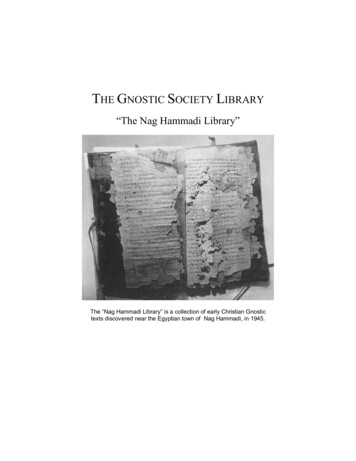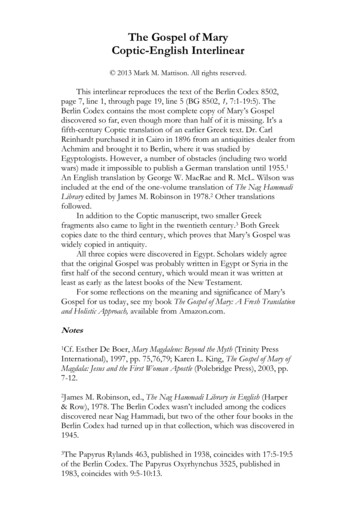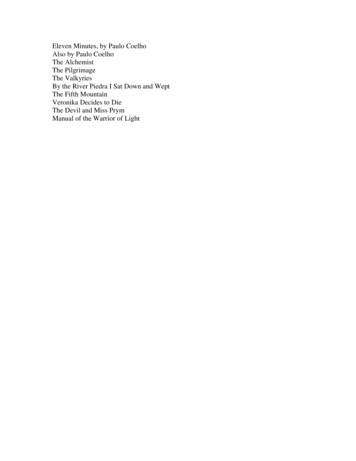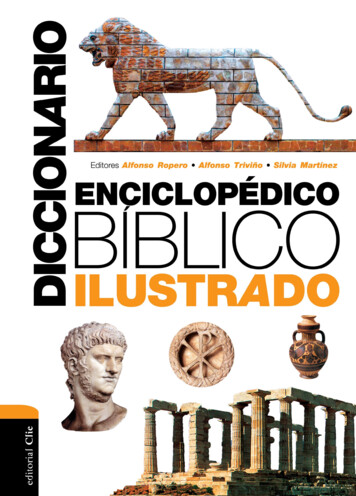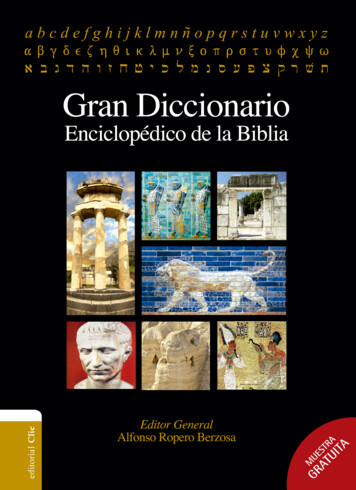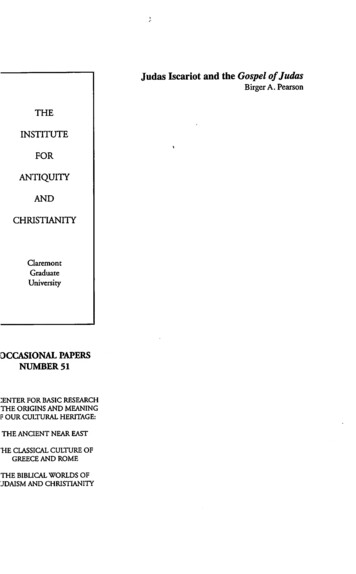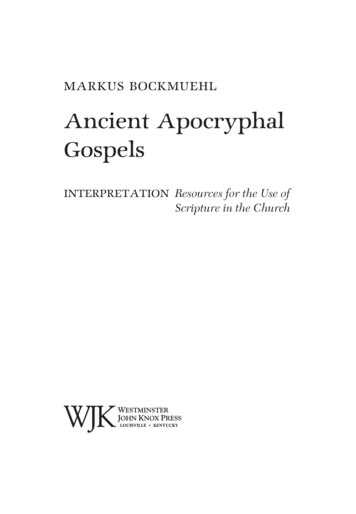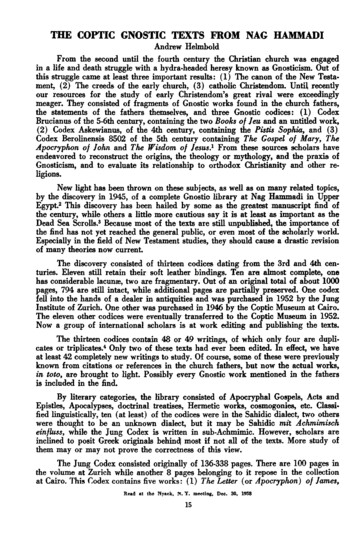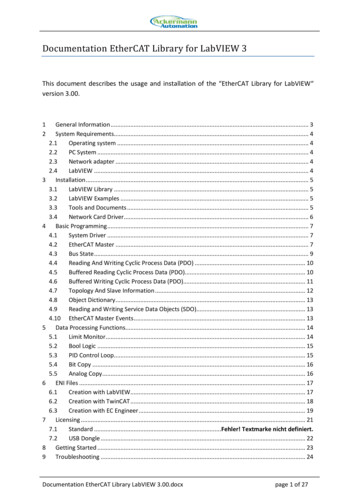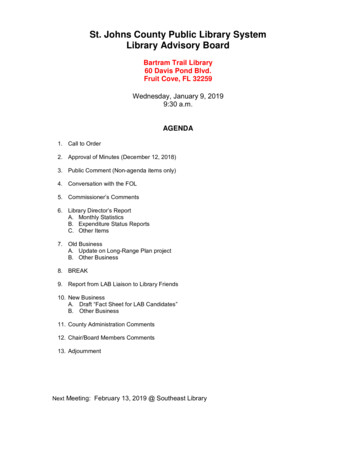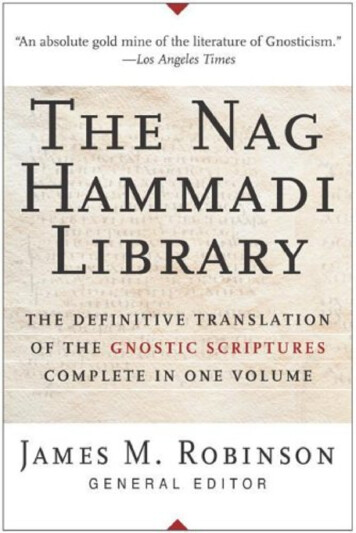
Transcription
The Nag Hammadi LibraryB I B L I O T H È Q U ED EN A GH A M M A D IIntroduction from « The Gnostic Gospels »by Elaine PagelsIn December 1945 an Arab peasant made an astonishing archeological discovery in Upper Egypt.Rumors obscured the circumstances of this find--perhaps because the discovery was accidental,and its sale on the black market illegal. For years even the identity of the discoverer remainedunknown. One rumor held that he was a blood avenger; another, that he had made the find nearthe town of Naj 'Hammádì at the Jabal al-Tárif, a mountain honeycombed with more than 150caves. Originally natural, some of these caves were cut and painted and used as grave sites asearly as the sixth dynasty, some 4,300 years ago.Thirty years later the discoverer himself, Muhammad 'Alí al-Sammán; told what happened.Shortly before he and his brothers avenged their father's murder in a blood feud, they had saddledtheir camels and gone out to the Jabal to dig for sabakh, a soft soil they used to fertilize theircrops. Digging around a massive boulder, they hit a red earthenware jar, almost a meter high.Muhammad 'Alí hesitated to break the jar, considering that a jinn, or spirit, might live inside. Butrealizing that it might also contain gold, he raised his mattock, smashed the jar, and discoveredinside thirteen papyrus books, bound in leather. Returning to his home in al-Qasr, Muhammad'All dumped the books and loose papyrus leaves on the straw piled on the ground next to theoven. Muhammad's mother, 'Umm-Ahmad, admits that she burned much of the papyrus in theoven along with the straw she used to kindle the fire.A few weeks later, as Muhammad 'Alí tells it, he and his brothers avenged their father's death bymurdering Ahmed Isma'il. Their mother had warned her sons to keep their mattocks sharp: whenthey learned that their father's enemy was nearby, the brothers seized the opportunity, "hacked offhis limbs . . . ripped out his heart, and devoured it among them, as the ultimate act of bloodrevenge."-1-
Fearing that the police investigating the murder would search his house and discover the books,Muhammad 'Alí asked the priest, al-Qummus Basiliyus Abd al-Masih, to keep one or more forhim. During the time that Muhammad 'Alí and his brothers were being interrogated for murder,Raghib, a local history teacher, had seen one of the books, and suspected that it had value. Havingreceived one from al-Qummus Basiliyus, Raghib sent it to a friend in Cairo to find out its worth.Sold on the black market through antiquities dealers in Cairo, the manuscripts soon attracted theattention of officials of the Egyptian government. Through circumstances of high drama, as weshall see, they bought one and confiscated ten and a half of the thirteen leather-bound books,called codices, and deposited them in the Coptic Museum in Cairo. But a large part of thethirteenth codex, containing five extraordinary texts, was smuggled out of Egypt and offered forsale in America. Word of this codex soon reached Professor Gilles Quispel, distinguished historianof religion at Utrecht, in the Netherlands. Excited by the discovery, Quispel urged the JungFoundation in Zurich to buy the codex. But discovering, when he succeeded, that some pageswere missing, he flew to Egypt in the spring of 1955 to try to find them in the Coptic Museum.Arriving in Cairo, he went at once to the Coptic Museum, borrowed photographs of some of thetexts, and hurried back to his hotel to decipher them. Tracing out the first line, Quispel wasstartled, then incredulous, to read: "These are the secret words which the living Jesus spoke, andwhich the twin, Judas Thomas, wrote down." Quispel knew that his colleague H.C. Puech, usingnotes from another French scholar, Jean Doresse, had identified the opening lines with fragmentsof a Greek Gospel of Thomas discovered in the 1890's. But the discovery of the whole text raisednew questions: Did Jesus have a twin brother, as this text implies? Could the text be an authenticrecord of Jesus' sayings? According to its title, it contained the Gospel According to Thomas; yet,unlike the gospels of the New Testament, this text identified itself as a secret gospel. Quispel alsodiscovered that it contained many sayings known from the New Testament; but these sayings,placed in unfamiliar contexts, suggested other dimensions of meaning. Other passages, Quispelfound, differed entirely from any known Christian tradition: the "living Jesus," for example,speaks in sayings as cryptic and compelling as Zen koans:Jesus said, "If you bring forth what is within you, what you bring forth will save you. If you do notbring forth what is within you, what you do not bring forth will destroy you."What Quispel held in his hand, the Gospel of Thomas, was only one of the fifty-two textsdiscovered at Nag Hammadi (the usual English transliteration of the town's name). Bound into thesame volume with it is the Gospel of Philip, which attributes to Jesus acts and sayings quitedifferent from those in the New Testament:. . . the companion of the [Savior is] Mary Magdalene. [But Christ loved] her more than [all] thedisciples, and used to kiss her [often] on her [mouth]. The rest of [the disciples were offended] . . .They said to him, "Why do you love her more than all of us?" The Savior answered and said tothem, "Why do I not love you as (I love) her?"Other sayings in this collection criticize common Christian beliefs, such as the virgin birth or thebodily resurrection, as naïve misunderstandings. Bound together with these gospels is theApocryphon (literally, "secret book") of John, which opens with an offer to reveal "the mysteries[and the] things hidden in silence" which Jesus taught to his disciple John.Muhammad 'Alí later admitted that some of the texts were lost--burned up or thrown away. Butwhat remains is astonishing: some fifty-two texts from the early centuries of the Christian era-including a collection of early Christian gospels, previously unknown. Besides the Gospel ofThomas and the Gospel of Philip, the find included the Gospel of Truth and the Gospel to theEgyptians, which identifies itself as "the [sacred book] of the Great Invisible [Spirit]." Anothergroup of texts consists of writings attributed to Jesus' followers, such as the Secret Book of James,the Apocalypse of Paul, the Letter of Peter to Philip, and the Apocalypse of Peter.What Muhammad 'Alí discovered at Nag Hammadi, it soon became clear, were Coptictranslations, made about 1,500 years ago, of still more ancient manuscripts. The originalsthemselves had been written in Greek, the language of the New Testament: as Doresse, Puech, andQuispel had recognized, part of one of them had been discovered by archeologists about fifty-2-
years earlier, when they found a few fragments of the original Greek version of the Gospel ofThomas.About the dating of the manuscripts themselves there is little debate. Examination of the datablepapyrus used to thicken the leather bindings, and of the Coptic script, place them c. A.D. 350-400.But scholars sharply disagree about the dating of the original texts. Some of them can hardly belater than c. A.D. 120-150, since Irenaeus, the orthodox Bishop of Lyons, writing C. 180, declaresthat heretics "boast that they possess more gospels than there really are,'' and complains that in histime such writings already have won wide circulation--from Gaul through Rome, Greece, andAsia Minor.Quispel and his collaborators, who first published the Gospel of Thomas, suggested the date of c.A.D. 140 for the original. Some reasoned that since these gospels were heretical, they must havebeen written later than the gospels of the New Testament, which are dated c. 60-l l0. But recentlyProfessor Helmut Koester of Harvard University has suggested that the collection of sayings in theGospel of Thomas, although compiled c. 140, may include some traditions even older than thegospels of the New Testament, "possibly as early as the second half of the first century" (50-100)-as early as, or earlier, than Mark, Matthew, Luke, and John.Scholars investigating the Nag Hammadi find discovered that some of the texts tell the origin ofthe human race in terms very different from the usual reading of Genesis: the Testimony of Truth,for example, tells the story of the Garden of Eden from the viewpoint of the serpent! Here theserpent, long known to appear in Gnostic literature as the principle of divine wisdom, convincesAdam and Eve to partake of knowledge while "the Lord" threatens them with death, tryingjealously to prevent them from attaining knowledge, and expelling them from Paradise when theyachieve it. Another text, mysteriously entitled The Thunder, Perfect Mind, offers an extraordinarypoem spoken in the voice of a feminine divine power:For I am the first and the last. I am the honored one and the scorned one.I am the whore and the holy one.I am the wife and the virgin.I am the barren one, and many are her sons.I am the silence that is incomprehensible.I am the utterance of my name.These diverse texts range, then, from secret gospels, poems, and quasi-philosophic descriptions ofthe origin of the universe, to myths, magic, and instructions for mystical practice.Why were these texts buried-and why have they remained virtually unknown for nearly 2,000years? Their suppression as banned documents, and their burial on the cliff at Nag Hammadi, itturns out, were both part of a struggle critical for the formation of early Christianity. The NagHammadi texts, and others like them, which circulated at the beginning of the Christian era, weredenounced as heresy by orthodox Christians in the middle of the second century. We have longknown that many early followers of Christ were condemned by other Christians as heretics, butnearly all we knew about them came from what their opponents wrote attacking them. BishopIrenaeus, who supervised the church in Lyons, c. 180, wrote five volumes, entitled TheDestruction and Overthrow of Falsely So-called Knowledge, which begin with his promise to setforth the views of those who are now teaching heresy . . . to show how absurd and inconsistentwith the truth are their statements . . . I do this so that . . . you may urge all those with whom youare connected to avoid such an abyss of madness and of blasphemy against Christ.He denounces as especially "full of blasphemy" a famous gospel called the Gospel of Truth. IsIrenaeus referring to the same Gospel of Truth discovered at Nag Hammadi' Quispel and hiscollaborators, who first published the Gospel of Truth, argued that he is; one of their criticsmaintains that the opening line (which begins "The gospel of truth") is not a title. But Irenaeusdoes use the same source as at least one of the texts discovered at Nag Hammadi--theApocryphon (Secret Book) of John--as ammunition for his own attack on such "heresy." Fiftyyears later Hippolytus, a teacher in Rome, wrote another massive Refutation of All Heresies to"expose and refute the wicked blasphemy of the heretics."-3-
This campaign against heresy involved an involuntary admission of its persuasive power; yet thebishops prevailed. By the time of the Emperor Constantine's conversion, when Christianitybecame an officially approved religion in the fourth century, Christian bishops, previouslyvictimized by the police, now commanded them. Possession of books denounced as heretical wasmade a criminal offense. Copies of such books were burned and destroyed. But in Upper Egypt,someone; possibly a monk from a nearby monastery of St. Pachomius, took the banned books andhid them from destruction--in the jar where they remained buried for almost 1,600 years.But those who wrote and circulated these texts did not regard themselves as "heretics. Most of thewritings use Christian terminology, unmistakable related to a Jewish heritage. Many claim to offertraditions about Jesus that are secret, hidden from "the many" who constitute what, in the secondcentury, came to be called the "catholic church." These Christians are now called gnostics, from theGreek word gnosis, usually translated as "knowledge." For as those who claim to know nothingabout ultimate reality are called agnostic (literally, "not knowing"), the person who does claim toknow such things is called gnostic ("knowing"). But gnosis is not primarily rational knowledge.The Greek language distinguishes between scientific or reflective knowledge ("He knowsmathematics") and knowing through observation or experience ("He knows me"), which is gnosis.As the gnostics use the term, we could translate it as "insight," for gnosis involves an intuitiveprocess of knowing oneself. And to know oneself, they claimed, is to know human nature andhuman destiny. According to the gnostic teacher Theodotus, writing in Asia Minor (c. 140-160),the gnostic is one has come to understand who we were, and what we have become; where wewere. whither we are hastening; from what we are being released; what birth is, and what isrebirth.Yet to know oneself, at the deepest level, is simultaneously to know God; this is the secret ofgnosis. Another gnostic teacher, Monoimus, says:Abandon the search for God and the creation and other matters of a similar sort. Look for him bytaking yourself as the starting point. Learn who it is within you who makes everything his ownand says, "My God, my mind, my thought, my soul, my body." Learn the sources of sorrow:, joy,love, hate . . . If you carefully investigate these matters you will find him in yourself.What Muhammad 'All discovered at Nag Hammadi is, apparently, a library of writings, almost allof them gnostic. Although they claim to offer secret teaching, many of these texts refer to theScriptures of the Old Testament, and others to the letters of Paul and the New Testament gospels.Many of them include the same dramatic personae as the New Testament--Jesus and his disciples.Yet the differences are striking.Orthodox Jews and Christians insist that a
What Muhammad 'Alí discovered at Nag Hammadi, it soon became clear, were Coptic translations, made about 1,500 years ago, of still more ancient manuscripts. The originals themselves had been written in Greek, the language of the New Testament: as Doresse, Puech, and Quispel had recognized, part of one of them had been discovered by archeologists about fifty - 2 - years earlier, when they .
